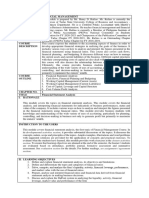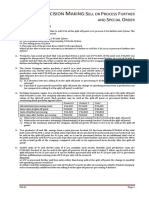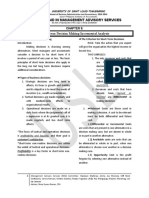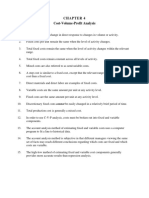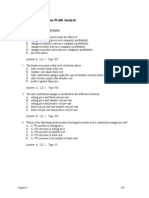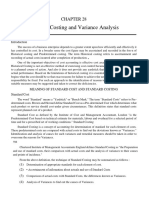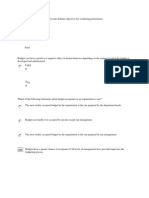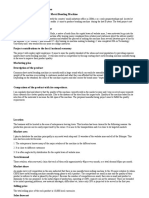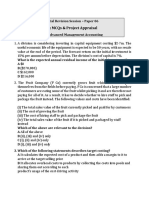Variable Costing vs. Absorption Costing
Variable Costing vs. Absorption Costing
Uploaded by
GêmTürÏngånÖCopyright:
Available Formats
Variable Costing vs. Absorption Costing
Variable Costing vs. Absorption Costing
Uploaded by
GêmTürÏngånÖOriginal Description:
Copyright
Available Formats
Share this document
Did you find this document useful?
Is this content inappropriate?
Copyright:
Available Formats
Variable Costing vs. Absorption Costing
Variable Costing vs. Absorption Costing
Uploaded by
GêmTürÏngånÖCopyright:
Available Formats
Variable Costing vs.
Absorption Costing
Lets take a look at the overview of these costing approaches:
Garrison and Noreen, (2013)
The above power point presentation slide illustrates a manufacturing business cost
structure. Take note of the Fixed Manufacturing Overhead, there lies the difference
between the two methods.
From the Income Statement that you have learned in your previous major
subjects like Fundamentals of Accounting, Financial Accounting, and Cost
Accounting, the operating performance of an entity for a period ended on a certain
date can be a net profit or a net loss. Then, looking at the Cost of Goods Sold
section, there is this Finished Goods Inventory, End or Merchandise
Inventory, where End is deducted from the items available for sale. Thus, the
ending finished goods inventory contributes to an increase in net profit. Can you
still remember that these accounts are used under the periodic inventory costing
method? They remain unsold for a certain period that ended; therefore, they are
not classified costs of goods sold.
In this module, the cost classification will be product or period costs, and
variable or fixed costs. For a manufacturer, the valuation of inventories (or product
costs) and the cost of goods sold (or period costs), in total or on a per unit basis are
very important. Full absorption costing and variable costing are other cost
classifications that we will learn this time. For your information, the Income
Statement that you prepared in your previous accounting subjects (Fundamental
Accounting, Financial Accounting and Cost Accounting) is that of a full absorption
costing approach. Moreover, they are prepared to cater to the needs of external
information users. From the income statement of a manufacturer, you identified
that the inventories are product costs while the cost of goods sold is a period cost.
Supplementary to the income statement is the Cost of Goods Manufactured, which
Variable Costing vs. Absorption Costing
presents the total product or manufacturing costs: the direct materials, direct labor
and manufacturing overhead. Fixed and variable costs do not appear in the
statement, but take note that this manufacturing cost is composed of variable and
fixed costs.
Another costing approach used in the income statement report is variable
costing. This costing method specifically caters to the needs of managers, a basic
tool in their decision making agenda.
How do we differentiate absorption costing from variable costing? To distinguish
one from the other, presented below is a summary of variable costing against
absorption costing:
EXHIBIT 7-1 Variable Costing versus Absorption Costing (Garrison and
Noreen, 2010)
Variable Costing vs. Absorption Costing
Another issue to be considered in absorption and variable costing methods is the
income effect of the size of inventory at the end of a particular reporting period. The
matrix that follows shows (Exhibit 7-1) the Comparative Income Effects Absorption
and Variable Costing (Garrison and Noreen 13th Ed. 2010 page 286.
RELATION
BETWEEN
PRODUCTIO
EFFEC
T ON
INVEN
RELATION BETWEEN
ABSORPTION AND
VARIABLE COSTING NET
Variable Costing vs. Absorption Costing
N AND
SALES FOR
THE
PERIOD
Units
produced
Units
Produced
Units
Produced
TORIE
S
OPERATING INCOME
No
change
=in
invent
ories
Absorption
Costing
Net
operating
income
Invent
>ory
Increas
e
Absorptio
n Costing
Net
operating
Income
<
Invent
ories
Decrea
se
Absorptio
n
Costing
Net
Operating
Income
>
<
Variable
costing
Net operating
income
Variable
Costing
Net
Operating
Income*
Variable
Costing
Net Operating
Income**
*Net operating income is higher under absorption
costing because fixed manufacturing overhead cost
is deferred in inventory under absorption costing
as inventories increase.
** Net operating income is lower under absorption
costing because fixed manufacturing overhead
is released from inventory under absorption
costing as inventories decrease.
As mentioned earlier in the first part of this module, the two costing methods are
applied in the income statement report. Presented hereunder are two income
statements illustrating the absorption and variable costing methods. From the two
income statements, take note of the difference in net operating income brought by
the fixed manufacturing component of the ending inventory under the absorption
costing method.
Variable Costing vs. Absorption Costing
Absorption Costing Method:
Sales (15,000 units x Php20 per
unit.
Php 300,000
Less: Cost of Goods Sold
Beginning Inventory
Add: Cost of goods manufactured
(16,000 units x Php12 per unit)
Php
-0192,000
Goods available for sale.
Php 192,000
Less: Ending Inventory
(1,000 units x Php12* per unit)
12,000**
Cost of Goods Sold..
180,000
Gross Margin.
Php 120,000
Less: Selling and Administrative
Expenses
Variable: 15,000 units x Php3 =
Php45,000
( Php45,000 + Php30,000 fixed )
75,000
NET OPERATING INCOME
Php 45,000
=======
===
Variable Costing Method:
Sales (15,000 units x Php20 per unit)
.
Php300,000
Less: Variable Expenses
Variable Cost of Goods Sold:
Beginning Inventory.
Add: Variable Manufacturing Costs
(16,000 units x Php7 per Unit)
..
Php
112,000
-0-
Variable Costing vs. Absorption Costing
Goods available for sale..
Less: Ending Inventory
(1,000 units x Php7 per unit)
Variable Cost of Goods Sold.
Variable Selling and Administrative
Expenses
(15,000 units x Php3)
Php
112,000
7,000***
Php
105,000
45,000
Contribution Margin.
150,000
Php150,000
Less: Fixed Expenses
Fixed Manufacturing Overhead..
Php 90,000
Fixed Selling and Administrative Expenses
30,000
Php110,000
NET OPERATING INCOME
Php40,000
=======
===
The assumed ending inventories of Php12.00 per unit have a fixed
manufacturing overhead cost components of Php5.00 per unit.
**
Under the Absorption Costing approach the Php12 per unit includes the
fixed manufacturing cost component of ending inventories.
**
*
In the next income statement (variable costing approach), the ending
inventories deducted from the goods available for sale are purely variable
costs.
The fixed component of manufacturing overhead is included in the
Php90,000 Fixed Manufacturing Overhead. Thus, this explains the
difference in net operating income between the two approaches (which is
1,000 units x Php5.00 = Php5,000). Specifically, it is the fixed
manufacturing cost component of the ending inventories.
To help you understand the impact of variable costing and absorption costing in the
decision-making process of management likewise, to appreciate the role of
Management Accounting, read the following topics pages 288 - 291 of our textbook.
Variable Costing vs. Absorption Costing
You might also like
- Cost Accounting Journal 2024-25 T.Y.Bcom (V)Document78 pagesCost Accounting Journal 2024-25 T.Y.Bcom (V)Shashikant Patel0% (1)
- MA Exercise Chap3Document22 pagesMA Exercise Chap3Mai Nữ Song NgânNo ratings yet
- 04 x04 Cost-Volume-Profit RelationshipsDocument11 pages04 x04 Cost-Volume-Profit RelationshipscassandraNo ratings yet
- Standard Costing and Variance AnalysisDocument17 pagesStandard Costing and Variance AnalysisLovely Mae LariosaNo ratings yet
- Notes Management AccountingDocument23 pagesNotes Management AccountingAbidNo ratings yet
- Historical Development of Cost AccountingDocument9 pagesHistorical Development of Cost AccountingBabasab Patil (Karrisatte)No ratings yet
- Plant Requirements For Manufacture Of: Block IceDocument30 pagesPlant Requirements For Manufacture Of: Block IceRavindra_1202No ratings yet
- Becker Study Question Bank SampleDocument42 pagesBecker Study Question Bank SampleNurul Shafina Hassan100% (2)
- Rate AnalysisDocument220 pagesRate AnalysisNehal Shah76% (17)
- Horngren Ima16 Tif 08 GEDocument49 pagesHorngren Ima16 Tif 08 GEasem shaban100% (3)
- Variable Costing and Absorption CostingDocument2 pagesVariable Costing and Absorption CostingPauline Bogador Mayordomo0% (1)
- Variable & Absorption CostingDocument23 pagesVariable & Absorption CostingRobin DasNo ratings yet
- High Low MethodDocument4 pagesHigh Low MethodSamreen LodhiNo ratings yet
- Standard Costing and Variance Analysis !!!Document82 pagesStandard Costing and Variance Analysis !!!Kaya Duman100% (1)
- Standard Costing and Variance AnalysisDocument11 pagesStandard Costing and Variance AnalysisMd Azim100% (1)
- Variable Costing and Absorption CostingDocument15 pagesVariable Costing and Absorption CostingRomilCledoro100% (1)
- 1.3 CVP AnalysisDocument2 pages1.3 CVP AnalysisLea GerodiazNo ratings yet
- Absorption Vs Variable CostingDocument8 pagesAbsorption Vs Variable CostingMary JaneNo ratings yet
- Lecture 10 Relevant Costing PDFDocument49 pagesLecture 10 Relevant Costing PDFShweta Sridhar57% (7)
- Cost and Cost ClassificationDocument10 pagesCost and Cost ClassificationAmod YadavNo ratings yet
- Cost Behavior and CVP Analysis PDFDocument22 pagesCost Behavior and CVP Analysis PDFJohn Carlo D. EngayNo ratings yet
- Module 11 - Standard Costing and Variance AnalysisDocument10 pagesModule 11 - Standard Costing and Variance AnalysisAndrea Valdez100% (1)
- Chap16-Standard Costing FOHDocument93 pagesChap16-Standard Costing FOHGeo Rublico ManilaNo ratings yet
- Working Capital ManagementDocument51 pagesWorking Capital ManagementNicole MantillaNo ratings yet
- Gross Profit Variation AnalysisDocument1 pageGross Profit Variation AnalysisJulie Ann Canlas100% (2)
- Differential Cost Analysis ExamplesDocument8 pagesDifferential Cost Analysis ExamplesMuhammad azeem100% (2)
- Variable & Absorption Costing LectureDocument11 pagesVariable & Absorption Costing LectureElisha Dhowry PascualNo ratings yet
- L-31, 32, 33,34 Standard CostingDocument52 pagesL-31, 32, 33,34 Standard CostingYashvi GargNo ratings yet
- Quantitative TechniquesDocument4 pagesQuantitative Techniquesshamel marohom100% (2)
- Absorption and Variable Costing Income Statement: Reporter: Sharmaine Laye M. PascualDocument20 pagesAbsorption and Variable Costing Income Statement: Reporter: Sharmaine Laye M. PascualPatrick LanceNo ratings yet
- Garrison FSA Solman PDFDocument39 pagesGarrison FSA Solman PDFGeraldo Mejillano100% (1)
- Standard Costing and Variance AnalysisDocument99 pagesStandard Costing and Variance AnalysisHaroon Zafar0% (1)
- Absorption and Variable CostingDocument2 pagesAbsorption and Variable CostingJenni Lorico67% (3)
- Lecture-8.1 Job Order Costing (Theory) PDFDocument15 pagesLecture-8.1 Job Order Costing (Theory) PDFNazmul-Hassan SumonNo ratings yet
- MS7301 Costs & Cost ConceptsDocument6 pagesMS7301 Costs & Cost ConceptsBetsy Soria JimenezNo ratings yet
- Absorption, Variable, and Throughput CostingDocument29 pagesAbsorption, Variable, and Throughput CostingNelissa L. Valencia100% (4)
- Managerial Accounting BudgetingDocument3 pagesManagerial Accounting BudgetingJoelyn Grace MontajesNo ratings yet
- Practical Accounting 2: STANDARD COSTING - Variance AnalysisDocument14 pagesPractical Accounting 2: STANDARD COSTING - Variance AnalysisAngelika Trasadas0% (1)
- Relevant Costing by A BobadillaDocument99 pagesRelevant Costing by A BobadillaShailene DavidNo ratings yet
- Chap8 PDFDocument63 pagesChap8 PDFFathinus SyafrizalNo ratings yet
- Mas 1.2.3 Assessment For-PostingDocument7 pagesMas 1.2.3 Assessment For-PostingJustine CruzNo ratings yet
- Absorption and Variable CostingDocument11 pagesAbsorption and Variable CostingalliahnahNo ratings yet
- MAS ReviewerDocument46 pagesMAS ReviewerjustjadeNo ratings yet
- University of Caloocan City Cost Accounting & Control Midterm ExaminationDocument8 pagesUniversity of Caloocan City Cost Accounting & Control Midterm ExaminationAlexandra Nicole IsaacNo ratings yet
- CVP AnalysisDocument3 pagesCVP AnalysisRaz MahariNo ratings yet
- MS 14 Variance AnalysisDocument3 pagesMS 14 Variance AnalysisDianneGarcia0% (1)
- Standard Costing and Variance AnalysisDocument7 pagesStandard Costing and Variance AnalysisGian Carlo RamonesNo ratings yet
- Mas 3 Module 1 Fs AnalysisDocument19 pagesMas 3 Module 1 Fs AnalysisHazel Jane EsclamadaNo ratings yet
- Cost Accounting Quiz 1 - Statement of Cost of Goods ManufacturedDocument4 pagesCost Accounting Quiz 1 - Statement of Cost of Goods ManufacturedMarkJoven BergantinNo ratings yet
- STANDARD COSTING and Variance AnalysisDocument30 pagesSTANDARD COSTING and Variance AnalysisAlthon Jay100% (1)
- Cost Concepts and Classifications (Final)Document3 pagesCost Concepts and Classifications (Final)Mica R.No ratings yet
- (Mas) 04 - Standard Costing and Variance AnalysisDocument7 pages(Mas) 04 - Standard Costing and Variance AnalysisCykee Hanna Quizo Lumongsod0% (1)
- MS02 Relevant Costs Special Order and Sell or Process FurtherDocument5 pagesMS02 Relevant Costs Special Order and Sell or Process FurtherIohc NedmiNo ratings yet
- CVP AssignmentDocument5 pagesCVP AssignmentAccounting MaterialsNo ratings yet
- Relevant Costing by A. BobadillaDocument43 pagesRelevant Costing by A. BobadillaRosario Diaz100% (2)
- Short Term Decision Making (OK Na!)Document12 pagesShort Term Decision Making (OK Na!)daemonspadechocoy100% (1)
- Absorption CostingDocument32 pagesAbsorption CostingAsal IslamNo ratings yet
- Process CostingDocument49 pagesProcess CostingAccounting Files100% (2)
- Chapter 04Document9 pagesChapter 04adarshNo ratings yet
- Chapter08.Cost Volume Profit AnalysisDocument38 pagesChapter08.Cost Volume Profit AnalysisIsaiah Cruz83% (6)
- Variance AnalysisDocument51 pagesVariance AnalysisAnonymous 5F68VLDbNo ratings yet
- Chapter EightDocument38 pagesChapter EightLauren Campbell100% (4)
- Kaplan Marginal & Absorption CostingDocument14 pagesKaplan Marginal & Absorption Costingalc4css25No ratings yet
- MAS 1 5. Variable CostingDocument7 pagesMAS 1 5. Variable Costingkeith niduelanNo ratings yet
- Absorption and Variable CostingDocument13 pagesAbsorption and Variable CostingalliahnahNo ratings yet
- Explain The Difference Between Variable and Absorption CostingDocument8 pagesExplain The Difference Between Variable and Absorption CostingJc QuismundoNo ratings yet
- Chapter 3 AkmenDocument28 pagesChapter 3 AkmenRomi AlfikriNo ratings yet
- Absorption & Variable CostingDocument40 pagesAbsorption & Variable CostingKaren Villafuerte100% (1)
- Activity Based Costing ER - NewDocument14 pagesActivity Based Costing ER - NewFadillah LubisNo ratings yet
- CH 20 Wiley Kimmel Quiz HomeworkDocument18 pagesCH 20 Wiley Kimmel Quiz Homeworkmki100% (2)
- Actual Costing enDocument8 pagesActual Costing enRajanNo ratings yet
- Variance AnalysisDocument5 pagesVariance AnalysisTonie NascentNo ratings yet
- Total Project CostDocument2 pagesTotal Project CostDonna Cece MelgarNo ratings yet
- MAC Summary of FormulasDocument25 pagesMAC Summary of FormulasRuNo ratings yet
- NCAA Financial Report - FY20Document80 pagesNCAA Financial Report - FY20Matt BrownNo ratings yet
- Cost-V Sem BBMDocument10 pagesCost-V Sem BBMAR Ananth Rohith BhatNo ratings yet
- ch11 171213165251Document38 pagesch11 171213165251Esraa ElbanhawyNo ratings yet
- Core-3: Cost Accounting UNIT-1Document3 pagesCore-3: Cost Accounting UNIT-1Santosh PatelNo ratings yet
- Business PlanDocument23 pagesBusiness PlanEahbm KaduNo ratings yet
- Assignment Cost Sheet SumsDocument3 pagesAssignment Cost Sheet SumsMamta PrajapatiNo ratings yet
- Standard Costing and Variance AnalysisDocument21 pagesStandard Costing and Variance Analysisback2rahul100% (1)
- 11 - Working Capital ManagementDocument39 pages11 - Working Capital Managementrajeshkandel345No ratings yet
- Strategic CostDocument6 pagesStrategic CostBuenaventura, Elijah B.No ratings yet
- 06.paper 06 - Mix MCQDocument9 pages06.paper 06 - Mix MCQHashan DasanayakaNo ratings yet
- Standard Costing 2024 - 1397583526Document20 pagesStandard Costing 2024 - 1397583526k.makwetu0No ratings yet
- Chapter 5 Non Integrated AccountsDocument52 pagesChapter 5 Non Integrated AccountsmahendrabpatelNo ratings yet
- Accountancy-I Subjective PDFDocument4 pagesAccountancy-I Subjective PDFM Umar MughalNo ratings yet
- Variableabsorption CostingDocument77 pagesVariableabsorption Costingandrea arapocNo ratings yet
- Mission Electronics Manufactures and Sells Basic DVD Players ForDocument1 pageMission Electronics Manufactures and Sells Basic DVD Players ForAmit PandeyNo ratings yet
- Saint Vincent College of Cabuyao Brgy. Mamatid, City of Cabuyao, Laguna Job Order Costing Prelim Exam-PART 1 I. True or FalseDocument6 pagesSaint Vincent College of Cabuyao Brgy. Mamatid, City of Cabuyao, Laguna Job Order Costing Prelim Exam-PART 1 I. True or FalseGennelyn Grace PenaredondoNo ratings yet















































